Stay in the know on all smart updates of your favorite topics.
Demoday #28: From Policy to Practice: Inclusive Design Ambitions of the Amsterdam Transport Authority

On the 5th of June, during the 28th Knowledge and Demo Day, we explored the topic of Inclusive Design in the context of mobility projects together with a diverse group of network partners. Iris Ruysch introduced the theme on behalf of the Amsterdam Transport Authority (Vervoerregio), while David Koop and Lotte de Wolde from our knowledge partner Flatland facilitated the session format, moderation and visual notes.
The ambition of the Amsterdam Transport Authority
The Amsterdam Transport Authority is responsible for public transport across fourteen municipalities in the region and is working towards a mobility system that enables people to travel quickly, safely and comfortably by public transport, bicycle or car. In addition to organising and funding public transport and investing in infrastructure, the Authority actively contributes to broader societal goals such as sustainability, health and inclusivity.
Inclusive mobility is one of the key themes within the wider mobility policy. The central principle is that everyone – regardless of age, income, disability, gender or background – should be able to travel well and comfortably throughout the region. This calls for a mobility system that is accessible, affordable, appropriate, socially safe and welcoming.
The aim of the session on 5 June was to work with the network towards an initial action plan for applying inclusive design principles in mobility projects. Iris is keen to ensure that the ambitions around inclusivity are not only stated in policy and vision documents but are truly embedded in the organisation – from policymakers to implementation teams.
Session set-up
After an introduction by Iris on the context and ambitions within the Transport Authority, we got to work. In small groups, participants explored the profile of the implementing civil servant (using a persona canvas) and considered desirable changes in approach; in terms of attitude, skills and collaboration.
We then used the Inclusive Design Wheel to examine how existing programme components of the Authority could be made more inclusive. In pairs, we tackled themes such as accessible travel information, social safety at stations (specifically for women), and improving bicycle parking facilities.
The Inclusive Design Wheel is an iterative process model that supports the structural integration of inclusivity into design and policy projects. The model emphasises collaboration, repetition, and continuous learning. It consists of four phases:
- Explore: Gather insights about users, their needs, and potential exclusion.
- Create: Develop ideas, concepts, and prototypes that address inclusive needs.
- Evaluate: Test whether the designs are inclusive, collect feedback, and make improvements where necessary.
- Manage: Ensure shared understanding, set goals, engage stakeholders, and embed the process.
Outcomes and insights
While the persona profiles were being developed, I observed the group discussions and noted several important insights to take forward in the development of the action plan:
- Awareness and concrete translation: Implementation teams often already have an intrinsic motivation to contribute to inclusivity goals set in policy. However, they may not always realise how their day-to-day work can support those goals. It’s important to continuously ask the question ‘How, exactly?’. Tools like checklists, templates and practical examples can support this translation from policy to practice.
- Flexible guidelines and not ‘extra work’: Given the differences in scale, pace and content of projects, guidelines need to be flexible. There must also be sufficient room in terms of time and budget. Most importantly, these guidelines and action plans should feel supportive, not like extra rules or bureaucracy. Too many rigid frameworks can backfire.
- Interaction between policy and implementation: There is a need for more two-way communication. Implementation teams want to be involved early in policy development, especially when they will be the ones carrying it out. They also want opportunities to reflect with policymakers on whether policy is being implemented as intended. This allows for timely feedback and course-correction based on real-world experience.
- An Inclusive Design mindset: Beyond sharpened policy documents and a stronger focus on the end user, Inclusive Design also requires a mindset – one that is inquisitive and reflective. Embedding this within the organisational culture will require more than just an action plan.
What’s next
Iris collected valuable input to kick-start the development of the action plan, and participants gained a better understanding of the Amsterdam Transport Authority, the principles of Inclusive Design, and what it takes to move from policy to implementation. This summer, a trainee will start at the Transport Authority to further develop this topic and the action plan. The session, this report, and Flatland’s visual notes provide a strong foundation to build on. We’ll be meeting with Iris and David to explore how we can support this follow-up.
Would you like to learn more about any of the topics or developments mentioned in this report? Feel free to email pelle@amsterdaminchange.com.
Data Dilemmas Recap: Using Data and AI for an Accessible Amsterdam
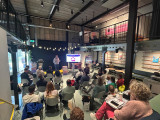
On September 26th, our community gathered in the AHK Culture Club at Marineterrein Amsterdam for our Datadilemma’s series. This edition focused on the use of Data and AI to create a more accessible Amsterdam. This article presents some of the key highlights and insights from the afternoon.
Together with the three speakers, Vishruth Krishnan, Hans Voerknecht, Michiel Bontenbal, and our audience we discussed how data and AI can help make our city more accessible for all. Which dilemma’s do we encounter when we use new technologies for an accessible city? How can data help to get more understanding of unequal access to mobility in the country? And what about sounds and noise pollution; how can data help make te city more livable?
What the three speakers had in common; a personal motivation to get away from the surface and dive deeper into the data, attempting to get closer to people’s experiences and perceptions. From an ordinary routeplanner, to one paying specific attention to challenges for people in weelchairs. From generic accesibility data for the region, to data highlighting the unequal distribution of access to mobility. And from recording noise levels, to measuring and classifying all different sounds in urban settings. In the paragraphs below, I will delve deeper into the different speakers and their topics.
Visruth Krishnan – Personalized Route Planner for People in a Wheelchair
To help individuals with limited mobility navigate the city more easily, the city’s innovation department has developed a prototype route planning tool. This route planner maps out the most accessible routes based on personal needs, considering preferences like maximum curb height at crossings, minimum sidewalk width, and whether to prioritize sidewalks or bike paths.
Visruth Krishnan, Data Scientist at the Innovation Department of the Municipality of Amsterdam, explained how data helps facilitate travel from point A to point B. However, to ensure route planning tools address the challenges faced by wheelchair users, we must feed these systems with data drawn from real-world experiences. A person’s journey might present specific challenges, such as detours, improperly parked bicycles, slopes, and narrow footpaths.
Working with a group of wheelchair users, Visruth studied the obstacles and experiences they encountered on their routes. This research generated precise data to feed the route planner, enabling it to provide personalized route suggestions that account for each individual’s freedom of movement.
Visruth presented several dilemmas encountered during the project:
- Subjectivity in the data: How busy is a sidewalk or intersection perceived to be? Are cyclists at a certain point fast and aggressive, or is that just a feeling?
- Minimal vs. comprehensive data collection: How much data should be gathered? While more data might provide deeper insights, it could also increase privacy risks.
- Accurate vs. timely data: Timely data may not always be accurate, and accurate data may not always be available in time for critical decision-making. Consider issues like illegally parked bikes, construction work, and terraces that vary in size and location depending on the season.
- Transparency vs. complexity: How transparent should data-driven processes be, especially when the algorithms or analytics behind them are complex? AI is often seen as a "black box"—people don’t understand how it works or how data is processed, which can lead to less trust from the start.
To address these challenges, Visruth and his team maintain an ongoing dialogue with the target audience. It’s an iterative process, and they keep the ‘human in the loop.’ The prototype is now ready, and hopefully, it can be further developed!
Hans Voerknecht – Unequal Accesibility and Data to Support The Narrative
Hans Voerknecht, strategist for sustainable accessibility at Een Nieuwe Kijk, presented the Integrated Perspective on Accessibility method, which he developed to get a deeper understanding of people’s accessibility. This method assists in collecting data and analyzing the severity of current inequalities and the effects of policy measures. The method has already been applied in nearly twenty projects, including four in the Amsterdam region, such as the Multimodal Future Vision of the Metropoolregio Amsterdam (MRA).
IKOB stands for "Integrale Kijk Op Bereikbaarheid" (Integrated Perspective/view on Accessibility). IKOB examines the travel time and costs that people face to reach their workplace by bike, car, or public transport and it visualizes how many jobs people can access from a specific area.
IKOB uses 'distance decay curves<strong>,'</strong> meaning that jobs located closer are given more weight than those further away. Travel time and costs are adjusted depending on the target group. Factors considered include income, access to a car, travel cost reimbursement, public transport options, and preference for a mode of transport (car, public transport, or bike). For people with a lower income, costs weigh more heavily than for those with higher incomes.
Throughout his talk, Hans discussed how data can be used to support a narrative, either consciously or unconsciously. Regional research on the state of mobility can quickly paint a positive picture if you're working with averages and fail to examine differences between people. There are groups that experience less access to mobility, and for whom this issue carries more weight due to financial constraints. The way data is researched and how deeply you investigate determines to what extent this group and their challenges are brought into focus.
One of the dilemmas Hans mentioned was the fact that poor accessibility is a personal experience. It’s subjective, and there can be a lot behind it. Regardless of the detail and quality of your data, you can never be completely sure if it truly reflects the human experience it’s supposed to represent.
Michiel Bontenbal – The Urban Sounds Sensor
Our third and final speaker discussed sounds and noise pollution in an urban environment. It may not seem to immediately fit with the rest of the speakers, but urban sound is also important to consider when creating an accessible and liveable city. Michiel Bontenbal, lecturer in business and IT courses at the Amsterdam University of Applied Sciences, told us more about the Urban Sounds sensor, developed in collaboration with the volunteer organization Sensemakers. He explained us more about the challenges they face with this AI-driven solution and raised some dilemmas in his work.
The Urban Sounds Sensor project was developed in response to the need for evidence of nighttime noise disturbances. It was crucial to be able to distinguish between different types of sounds, such as music, mopeds, alarms, doors, car noises, and honking.
Together with the volunteers from Sensemakers, Michiel designed the sensor in such a way that the recorded sounds are neither stored nor released. The microphone registers the sound, and the algorithm in the sensor immediately categorizes it within the device. This approach ensures privacy by design.
Training the sensor is still an ongoing process. Achieving high accuracy is challenging, as even humans sometimes have trouble identifying certain sounds. And, while measuring noise disturbances is definitely getting more attention in the city now. However, this specific method of distinguishing between sound categories is still lagging behind in both development and interest from government authorities.
Michiel concluded his presentation by discussing his dilemmas with the audience. One of his dilemmas, as expected, was about placing microphones in public spaces; how desirable is that, really? It's important to talk about ethics and privacy when measuring in public spaces, especially with a sound sensor that isn’t visible. His second point focused on the experience of city sounds. How you perceive sounds depends on personal experiences and preferences. Some people enjoy urban sounds, like the noise of a tram or ringing bike bells. People may have associations with certain sounds that determine whether they find them annoying, don't even notice them, or actually enjoy them. This is a factor that a sound sensor and the data it collects have difficulty accounting for.
Panel Discussion
After the presentations, we brought the speakers together for a panel discussion. Led by Chris de Veer, programme manager Mobility at Amsterdam InChange, there was an engaging conversation with the audience. To wrap things up, I’d like to highlight three key statements made by the speakers in response to some critical questions from the audience:
- "We often try to objectify the world with data, but there is no objective truth. However, diving deep into data can give you a better and more diverse understanding of an issue or region." – Hans
- "Data is always messy. If the data we input is messy, the outcome will also be messy. Garbage in, garbage out." – Michiel
- “The Route Planner method and platform could be of great use in gaining a better overview of building accessibility throughout the city.” - Visruth
Thanks to the speakers for their stories and to the audience for the lively discussions afterwards. Want to join us for our next Data Dilemmas event? The next edition of this series of open events will be announced soon. We’re also always open to new themes and topics for this series; we’re curious to hear about the data dilemmas you encounter in your work!
Demoday #22: Inclusive Prosperity & The Case Of Experiments In Public Space

*This article makes use of the term Inclusive Prosperity as the English translation for the Dutch word; ‘Brede Welvaart’
In The Netherlands, the concept of Inclusive Prosperity* is on the rise. Policy makers are busy defining this concept, figuring out how to put this concept into practice and what it means for their decision-making process. Together with his colleagues at the Municipality of Amsterdam, Yurhan Kwee hosts sessions on decision-making along the principles of Inclusive Prosperity. With the input he gathers, he hopes to make the decisions needed for our Inclusive Prosperity ambitions more understandable and transparent, both for Amsterdam’s administrators and councillors as well as its citizens.
Inclusive Prosperity
Inclusive Prosperity is about more than just money. It involves everything that people consider valuable, such as health, the quality of education, the environment, a safe living environment, and equal opportunities for everyone. It's about the quality of life in the present, and the extent to which this affects the prosperity of future generations or those of people elsewhere in the world.
According to the definition, used by the Municipality, there are 8 themes to consider:
1. Subjective Well-being
Subjective well-being refers to the evaluation people make of their lives. Consider the question, "How satisfied are you with life in general?"
2. Health
The theme of Health encompasses physical illnesses and conditions, as well as mental health, living with limitations, perceived health, and self-regulation and resilience.
3. Consumption and Income
The theme of Consumption and Income refers to how income provides people with the freedom and opportunities to consume, including purchasing services and goods, maintaining a financial buffer, and shaping one's lifestyle.
4. Education and Training
Thinking about the theme of Education and Training involves the transfer of knowledge and skills, socialization, and considering the education or training experiences of individuals.
5. Spatial Quality and Cohesion
Regarding the theme of Spatial Cohesion and Quality, consider the following: a qualitatively well-designed space is a crucial precondition for the perceived broad prosperity. This includes spatial design on a functional level and with a focus on the future.
6. Economic Capital
Depending on the case, consider how it relates to:
- Human capital: the combination of competencies, knowledge, and skills;
- Physical capital: material possessions, such as machinery, buildings, and infrastructure;
- Knowledge capital: intangible assets, such as research and development, data, and patents;
- Financial capital: the financial resources of households and the government (purchasing power).
7. Natural Capital
Natural Capital refers to the stock of natural resources. Consider items such as (drinking) water, food, minerals, wind-sun-water energy, biodiversity, etc. Assess whether they are sufficiently available, in shortage, or if there is damage to these resources.
8. Social Capital
The concept of Social Capital often refers to the benefits of social networks, such as access to information and resources. This involves connections within and between groups. Positive effects can lead to trust, while negative effects can lead to loneliness.
Experimenting (with Mobility related policies) in public space
The case we used during this session is the use of experiments in public space, altering mobility or travel infrastructure. The months leading up to this afternoon, Amsterdam had put different experiments into practice (e.g. de ‘knip’ and de ‘paaltjesproef’) resulting in heated discussions, about both the success and desirability of using this method.
In a more objective manner, we used the Broad Prosperity principles to argue why its either desirable or undesirable to put such methods into practice.
Results
The group agreed that these Amsterdam experiments, concerned with creating calmer, more liveable urban areas, score well within themes like; Health (less air & noise pollution), Nature (more space for green and biodiversity), Social capital (more space and opportunity to meet and interact), Spacial quality (less dangerous and more moving space) and education (experimenting, learning by doing, viewing urban planning as experimenting and an ongoing learning process). However, as this year’s backlash on the experiments showed, there are some negative aspects to consider. Examples of domains in which we found some negative aspects, were; Economy (decreased speed and efficiency), Consumption & Income (local shop- and restaurant-owners need to be flexible and could be victims of changing infrastructure) and Subjective Well-being (citizens feel used, disadvantaged, and there is ambiguity about the purpose).
We found it difficult to arrive at a common answer because advantages and disadvantages exist on each theme separately. However, there was a common notion that the success of this method is rooted in clear and transparent communication on the effects and goals of such experiment. Frustration should be minimized and the opposing arguments should be taken seriously. Furthermore, we discussed the difference between a ‘real’ experiment in which every outcome is a success, and a trial, which is used to test a policy that’s envisioned for future years. The one who initiates the experiment should have this very clear for itself.
While one of the strengths of this method is the need to value these different domains in a more equal and objective manner, it proved to be difficult in practice. We all had the tendency to give some aspects more weight than others. While we were supposed to set up an advice and practice with decision-making along the principles of Inclusive Prosperity, it turned out to be challenging to let go of our prior experience, prejudices and opinions on this subject. We weren’t sure whether this is always a negative thing, but it’s one of the considerations Yurhan took home in the Municipality’s exploration of this approach.
Together, we experienced the challenge of working together with a new concept and approach. It should be an ongoing practice and discussion, a collective effort. Sessions like these serve that purpose perfectly.
Feel free to get in touch with me if you want to know more about the municipality’s and Amsterdam Economic Board’s efforts on the topic of Inclusive Prosperity.
Deelscooteraanbieder Check introduceert een veiligheidsslot
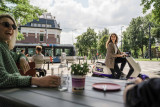
Deelscooteraanbieder Check introduceert vandaag een veiligheidsslot in haar app: de Safety Lock. De Safety Lock is ontworpen in afstemming met jongerenorganisatie TeamAlert. Met het slot kunnen gebruikers de eigen Check app tijdelijk blokkeren voor het reserveren van voertuigen. Op deze manier beschermt de gebruiker zichzelf tegen het (laagdrempelig) gebruik maken van scooters op een later tijdstip. Naast de Safety Lock introduceert Check ook een gerichte communicatiecampagne om gebruikers op relevante momenten te wijzen op de gevolgen van rijden onder invloed.
TeamAlert: ‘Actie nodig om dronken jongeren van deelscooter te houden’
In februari 2023 publiceerde TeamAlert, een organisatie die zich inzet voor de verkeersveiligheid van jongeren, een enquête waaruit blijkt dat ruim een kwart van de jonge deelscootergebruikers met een leeftijd tot en met 24 jaar wel eens onder invloed op een deelscooter stapt en de risico’s daarvan onderschat. De enquête was onder bijna duizend jongeren afgenomen. Naar aanleiding van het onderzoek riep TeamAlert gemeenten en deelscooteraanbieders op om in actie te komen en na te denken over oplossingen.
Deelscooteraanbieder Check introduceert de Safety Lock
Het onderzoek van TeamAlert, in combinatie met een landelijke toename van het gebruik van alcohol en drugs in het verkeer in 2022 (37,4% meer uitgedeelde boetes), is aanleiding geweest voor deelscooteraanbieder Check om in actie te komen. Op basis van meerdere gesprekken en feedbacksessies met deelscootergebruikers en verschillende autoriteiten op het gebied van verkeersveiligheid, waaronder TeamAlert, introduceert Check vandaag de Safety Lock. Met het slot kan elke gebruiker de eigen Check app tijdelijk blokkeren voor het reserveren van voertuigen. Op deze manier beschermt de gebruiker zichzelf tegen het (laagdrempelig) gebruik maken van scooters op een later tijdstip. Mochten gebruikers het slot toch willen deactiveren, omdat ze bijvoorbeeld niet onder invloed zijn, dan moeten ze eerst verplicht één minuut lang een tutorial over de gevolgen van rijden onder invloed bekijken. Gebruikers die het slot activeren worden gestimuleerd om hun Safety Lock te delen met vrienden om uit te dragen dat onder invloed zijn en rijden, niet samen gaat.
De Safety Lock helpt de gebruiker bij het maken van de juiste keuze
Saar Hadders, gedragsonderzoeker bij TeamAlert, legt uit hoe de Safety Lock gebruikers in staat stelt om de juiste keuzes te maken: “Onder sommige gebruikers geldt een sociale norm dat het rijden onder invloed op een deelscooter normaal is. Door het bedenken van een nieuwe feature om rijden onder invloed op deelscooters tegen te gaan, zendt Check een krachtige boodschap uit dat dit gedrag niet oké is. In de omgeving van jongeren zijn vrienden erg belangrijk in het creëren van een veilige sociale norm. Doordat de Safety Lock gebruikers stimuleert om de feature met hun vrienden te delen, wordt deze sociale norm versterkt.”
Hadders: “Jongeren hebben niet altijd de intentie om na een avondje stappen onder invloed te gaan rijden, maar door een combinatie van impulsiviteit en het effect van alcohol kan deze intentie vervagen. De Safety Lock biedt jongeren de mogelijkheid om zichzelf vóórdat ze hun eerste drankje drinken, te behoeden voor een onveilige rit naar huis. Wanneer gebruikers in de loop van de avond tóch van gedachten veranderen, deelt Check kennis over waarom het goed is om nuchter te rijden. Deze kennis kan helpen om alsnog het veilige gedrag te vertonen en ander vervoer te kiezen.”
De Safety Lock wordt versterkt door gerichte en relevante communicatie
Check heeft de communicatie om rijden onder invloed tegen te gaan opgedeeld in drie tijdvakken. De tijdvakken zijn gebaseerd op onderzoek van het SWOV. Afhankelijk van het tijdvak worden gebruikers aangemoedigd tot verantwoordelijk gedrag in het verkeer, bijvoorbeeld door gebruikers voorafgaand aan een avondje uit te attenderen op de mogelijkheid om het Safety Lock te activeren. Gebruikers die vrijdag- of zaterdagnacht tussen 23.00 uur en 06.00 uur een deelscooter willen pakken moeten eerst verplicht een tutorial kijken over de gevolgen van rijden onder invloed.
Walkability index for Amsterdam 🚶♀️

🚶♀️ How walkable is Amsterdam? 🚶♂️
🏘️ Ever wondered how pedestrian-friendly is your neighbourhood?
Do you feel encouraged and safe to walk in your surroundings?
Do the streets have too much traffic 🚦 and not enough trees 🌳?
Together with Vasileios Milias, we've developed CTstreets map, a new tool where you can check how your street scores in different walkability factors and what might be missing to make it more attractive for pedestrians.
👀 Explore the web tool here: https://miliasv.github.io/CTstreets/?city=amsterdam#15.18/52.371259/4.895385/0/45
🔍 Dive into the methodology and process on our info page: https://miliasv.github.io/CTstreets/info_page/
CTstreets is based on the results of my thesis "Amsterdam on Foot" where I developed a participatory approach to evaluate walkability in every street segment of Amsterdam using open data.
The categories available on the map are Overall walkability, Landscape, Crime Safety, Traffic Safety, Proximity and Infrastructure.
📍 With this tool, you can check how is the walkability per street, neighbourhood or walkshed (5 or 15 minutes) and switch between categories.
A disclaimer about the results presented: While based on the opinions of municipality workers, urban designers and advocates for pedestrian accessibility, this work might not reflect the opinion of everyone. After all, walkability is also influenced by personal factors. Furthermore, the data we used comes from open sources and it might not always be accurate / up to date. Ctstreets aims to enable the exploration of factors that impact walkability according to the experts in a simple, interactive, and fun way, and spark a conversation about how we think and design for pedestrians.
18. Space for sporting and playing in a green environment

This is the 18th episode of a series 25 building blocks to create better streets, neighbourhoods, and cities. This message is about the limited possibilities for children to play in a green environment because of the sacrifices that are made to offer space for cars and private gardens
Almost all residential areas in the Netherlands offer too little opportunity for children to play. This post deals with this topic and also with changing the classic street pattern to make way for routes for pedestrians and cyclists.
Everything previously mentioned about the value of a green space applies to the living environment. The rule 3 : 30 : 300 is often used as an ideal: Three trees must be visible from every house, the canopy cover of the neighborhood is 30% and within an average distance of 300 meters there is a quarter of a hectare of green space, whether or not divided over a number of smaller parcels.
Functions of 'green' in neighbourhoods
The green space in the living environment must be more than a grass cover. Instead, it creates a park-like environment where people meet, it is accompanied by water features and can store water in case of superfluent rain, it limits the temperature and forms the basis for play areas for children.
Legally, communal, and private green areas are different entities; in practice, hybrid forms are becoming common. For example, a communal (inner) garden that can be closed off in the evening or public green that is cadastral property of the residents but intended for public use. In that case the residents live in a park-like environment which they might maintain and use together. Het Rivierdistrict in Utrecht is an example of this.
Play at the neighborhood level
Children want wide sidewalks and a place (at least 20 x 10 m2) close to home that is suitable for (fantasy) games and where there may also be attractive play equipment. The importance of playground equipment should not be overestimated. For many children, the ideal playground consists of heaps of coarse sand, water, climbing trees and pallets. To the local residents It undoubtedly looks messier than a field full of seesaw chickens. Good playground equipment is of course safe and encourages creative action. They can also be used for more than one purpose. You can climb on it, slide off it, play hide and seek and more. Of the simple devices, (saucer) swings and climbing frames are favorites.
A somewhat larger playground to play football and practice other sports is highly regarded. Such a space attracts many children from the surrounding streets and leads to the children playing with each other in varying combinations.
Squares
Most squares are large bare plains, which you prefer to walk around. Every neighborhood should have a square of considerable size as a place where various forms of play and exercise are concentrated. In the middle there is room for a multifunctional space - tastefully tiled or equipped with (artificial) grass - for ball games, events, music performances, markets and possibly movable benches. Ideally, the central part is somewhat lower, so that there is a slope to sit on, climb and slide down. On the edge there is room for countless activities, such as different forms of ball games, a rough part, with climbing trees, meeting places, spaces to hide, space to barbecue and walls to paint, but also catering and one or more terraces. Lighting is desirable in the evening, possibly (coloured) mood lighting. There is an opportunity for unexpected and unforeseen activities, such as a food car that comes by regularly, street musicians that come to visit, changing fairground attractions and a salsa band that comes to rehearse every week.
Such a square can possibly be integrated into a park that, apart from its value as a green space, already offers opportunities for children to play. Adding explicit game elements makes parks even more attractive.
Connecting car-free routes
Safe walking and cycling routes connect playgrounds, parks, and homes. They offer excellent opportunities to use bicycles, especially where they are connected to those of other neighbourhoods.
By seeing facilities for different age groups in conjunction, networks and nodes are created for distinctive target groups. The children's network mainly includes play areas close to home, connected via safe paths to playgrounds in the vicinity. Facilities especially for teenagers are best located somewhat secluded, but not isolated. Essentially, they want to fit in. The teenage network also includes places where there is something to eat, but also various facilities for sports and at a certain age it includes the entire municipality.
Follow the link below to find an overview of all articles.
15. Affordable housing

This is the 15th episode of a series 25 building blocks to create better streets, neighbourhoods, and cities. This post is about one of the most serious threats to the quality of the living environment, namely the scarcity of housing, which is also unaffordable for many.
In many countries, adequate housing has become scarcer and too expensive for an increasing number of people. Unfortunately, government policy plays an important role in this. But good policy can also bring about a change. That's what this post is about.
As in many other developed countries, for a large part of the 20th century, the Dutch government considered it as its task to provide lower and middle classes with good and affordable housing. Housing associations ensured the implementation of this policy. Add to this well-equipped neighborhood shopping centers, ample medical, social, educational and transportation facilities and a diverse population. When the housing shortage eased in the 1970s, the nation was happier than ever. That didn't take long.
The emergence of market thinking in housing policy
During the last decades of the 20th century, the concern for housing largely shifted to the market. Parallel to this, housing corporations had to sell part of their housing stock. Mortgages were in easy reach and various tax facilities, such as the 'jubelton' and the mortgage interest deduction, brought an owner-occupied home within reach of many. In contrast, the waiting time for affordable rental housing increased to more than 10 years and rental housing in the liberalized zone became increasingly scarce and expensive. In Germany and Austria, providing good housing has remained a high priority for the government and waiting times are much shorter. The photo at the top left part shows the famous housing project Alt Erla in Vienna. Bottom shows left six affordable homes on the surface of one former home in an American suburb and top right is the 'Kolenkit', a social housing project in Amsterdam.
The explosive rise in housing costs
In order to adapt housing cost to the available budget, many people look for a house quite far away from the place where they work. Something that in turn has a negative effect on the travel costs and the time involved. Others settle in a neighborhood where the quality of life is moderate to poor or rent a too expensive house. More than a million households spend much more than the maximum desirable percentage of income (40%) on housing, utilities, and transport.
Between 2012 and 2022, the average price of a home in the Netherlands rose from €233,000 to €380,000. In Amsterdam, the price doubled from €280,000 to €560,000. Living in the city is becoming a privilege of the wealthier part of the population.
It is often assumed that around 900,000 housing units will be needed in the Netherlands by 2030, of which 80% is intended for single-person households.
An approaching change?
It seems that there is a shift going on, at least in policy thinking. The aim is to build an average of 100,000 homes per year in the coming years and to shorten the lead time between planning and realization. Achieving these intentions is uncartain because construction is being seriously delayed by the nitrogen crisis. The slow pace of new construction has once again drawn attention to the possibility of using existing houses and buildings for a significant proportion of these new housing units. More so as it is estimated that 80% of demand comes from single-person households.
The existing housing stock offers large potential for the creation of new living spaces. This potential has been investigated by, among others, the Kooperative Architecten Werkplaats in Groningen, resulting in the report <em>Ruimte zat in de stad</em>. The research focuses on 1800 post-war neighbourhoods, built between 1950 and 1980 with 1.8 million homes, 720,000 of which are social rental homes. The conclusion is that the division and expansion of these homes can yield 221,000 new units in the coming years. Eligible for this are single-family houses, which can be divided into two, and porch apartment blocks, which can be divided into more units per floor. Dividing up existing ground-access homes and homes in apartment blocks is technically not difficult and the costs are manageable. This applies even more if the adjustments are carried out in combination with making the relevant homes climate neutral. In addition, huge savings are made on increasingly expensive materials.
Even more interesting is to combine compaction with topping. This means the addition of one or two extra floors, so that a lift can also be added to the existing apartments. In construction terms, such an operation can be carried out by using light materials and installing an extra foundation. A project group at Delft University of Technology has designed a prototype that can be used for all 847,000 post-war porch houses, all of which need major maintenance. This prototype also ensures that the buildings in which these homes are located become energy-neutral and include facilities for socializing and play. Hence the extra wide galleries, with stairs between the floors and common areas in the plinth (image below right).
Follow the link below to find an overview of all articles.
De stad van de toekomst bouwen ze in Almere in Minecraft

Met een spetterende kick-off door Justin Edwards, Director of Learning Programmes van Microsoft, zijn 200 studenten van hogeschool Windesheim Flevoland vandaag in teams gestart met het in Minecraft bouwen van het nog te realiseren stadsdeel Pampus. Bijzonder omdat Almere als tweede stad na London start met een Minecraft challenge voor de realisatie van een nieuwbouwopgave. Het winnende studententeam van Windesheim mag haar concept van 7 – 9 november presenteren in het Holland paviljoen tijdens de Smartcity Expo World Congres in Barcelona.
De komende anderhalf jaar biedt Almere honderden jongeren tussen de 8 en 21 jaar op deze unieke manier de kans om zelf op de stoel van de architect te zitten en zo mee te denken over grote maatschappelijke vraagstukken. Basisschoolleerlingen en studenten bouwen op hun eigen niveau aan een virtueel Almere Pampus. Dit als plek waar zij in de toekomst zelf willen wonen. Dit stadsdeel bouwen ze met een speciale versie van Minecraft Education Edition.
Wethouder Maaike Veeningen van Almere (Economische ontwikkeling, hoger onderwijs): ‘we dagen leerlingen tot 21 jaar uit om met oplossingen te komen voor vraagstukken op het gebied van duurzaam, energiezuinig en inclusief bouwen. Op deze manier leren zij bijvoorbeeld over het gebruik van Artificial Intelligence (AI), Virtual Reality (VR) en robotisering bij het ontwikkelen van een nieuw stadsdeel. Zo betrekken we onze toekomstige inwoners bij het bouwen aan de ideale stad van de toekomst.’
Toekomstige leefomgeving
Het toekomstige Almere Pampus wordt in het zuidwesten van Almere gebouwd, met meer dan 30.000 woningen en 16.000 arbeidsplaatsen. Projectdirecteur Almere Pampus en senior stedenbouwkundige bij de gemeente Almere Paola Huijding over de Minecraft Challenge: “Deze leerlingen zijn misschien de toekomstige bewoners van Pampus. Hiermee bouwen we aan woon- en werkplekken omringd door water en groen. Het is daarom zo mooi dat juist de toekomstige generatie nu meedenkt over hun leefomgeving.”
Digitaalvaardig
De speciale editie van Minecraft die de studenteams gebruiken is ontwikkeld door Iamprogrez. Het gebruik ervan moet op een speelse en laagdrempelige manier bijdragen aan een digitaal vaardige samenleving. Scholieren krijgen zo inzicht in de banen van de toekomst. Ook kunnen zij in een buddysysteem ouderen meenemen in hun digitale kennis en vaardigheden.
Fleur van Beem, Executive Director bij VodafoneZiggo: “Het vooruithelpen van twee miljoen mensen in de samenleving willen wij bereiken door initiatieven als Online Masters, een online lesprogramma voor scholen over de digitale wereld. De Minecraft Challenge sluit hierop naadloos aan en het is natuurlijk fantastisch om dankzij gamification jongeren digitaalvaardig te krijgen.”
Bouwen aan innovatieve concepten
De leerlingen kunnen alleen of in teams werken aan de challenge en krijgen hiervoor een digital skills-certificaat. Na de ontwerpfase, kunnen zij hun toekomstige visie op Pampus uploaden op de website van de Green Innovation Hub (GIH). Een groep experts kiest de winnaar. Danny Frietman, Projectdirecteur van de GIH: “De winnende uitkomsten van de Minecraft Challenge vormen de basis voor ons om start-ups en scale-ups uit te dagen om de concepten van de scholieren daadwerkelijk in de praktijk te brengen.”
“Hoe ziet het er dan uit”
Kijk HIER naar de video aankondiging van de eerder gehouden Minecraft-challenge in Londen. Daarin zie je duidelijk hoe de challenge werkt en welke mogelijkheden Minecraft hiervoor biedt.
Fotografie Daan Klunder, Almere City Marketing
Upcoming disaster

Everyone should read the latest IPCC report. Current global policies are heading for a global warming of 3.2% in 2100. Although we have to continue emphasizing the necessity of radical policy change, at the same time, we must do more to mitigate the consequences of this increase in temperature.
I have made a short summary of the report (in Dutch), to be downloaded below
Demoday #19: Mobility as a Commons worksession

In the coming decades, urban population growth and a rising demand for mobility options will cause strain on our public spaces. The city of Amsterdam will counteract this trend by making private car ownership less attractive for its citizens, while making sure there are enough, well facilitated, alternative modes of transport. One could think of investments in (more) public transport, and the welcoming of shared mobility providers. Currently, some market players are making use of the latter and sharing cars and sharing mopeds are becoming part of the streetscape. Is this enough?
Mobility as a Commons
On the 23th of March, Diederik Basta and Jop Pék from the municipality of Amsterdam’s innovation department, hosted a working session on the concept of; Mobility as a Commons (MaaC). They introduced this concept by pointing out that currently, we’re not ‘sharing’ our modes of transport but we’re just ‘renting’ them from private companies. This raises a couple of concerns; these parties exist purely to maximize profits, they own and sell user data, their fleet of vehicles is not spread evenly throughout the city, and because it’s only available for those who can afford the service, it’s not inclusive for all.
The municipality is now exploring how to move away from these market mechanisms and facilitate car sharing solutions based in local ownership. This summer, they’ll experiment with pilots in which modes of transport are perceived as a ‘Commons’ and cooperatively owned and used by a group of local residents. Their goal is to gather insights on how to facilitate this form of locally organized mobility in the best way possible and pave the way for emerging initiatives.
Paradigm shifts
For this new alternative to succeed, drastic innovation is needed in which public authorities identify and alter their role. That’s why Diederik and Jop are also turning inwards and critically reflecting on the current premises from which they’re acting. Only then, you’ll be able to innovate in a way that you’re breaking free from your current paradigm and its effects. Because they are of such importance, I would like to quickly summarize the three relevant premises:
- People act out of self-interest; we assume mistrust. People need control and governance to reinforce the common good. Its effects: A government mistrusting its citizens and legal sealing of documents and procedures.
- The municipality owns public space. Public space should be designed and managed by experts to ensure quality, consistency and efficiency of functionalities. Its effects: Struggles with public participation and a focus on efficiency and functionality, instead of social interaction.
- The municipality is responsible for a well-functioning mobility system. Public space makes way, and more urban mobility makes people richer and happier. Its effects: Private parties push the mobility system and the government facilitates this, and traveling for work and other (social) activities is the norm.
Reactions from the participants
Next to inspiring the working session participants, Diederik and Job wanted to ignite an active conversation with the diverse group in front of them. They wanted to show the parties at the table how important it is to realise from what kind of premises and paradigm you’re currently ‘innovating’, but they were also curious what others thought of their upcoming project.
A big theme during the discussion was the fact that this ‘commons’ thinking is finding its way within different themes like the energy- and data transition. Energy cooperatives are emerging at a fast rate and this topic is receiving a lot of research and attention from energy companies at the moment. The same goes for cooperative ownership and use of data, as an alternative to protection and the commercial use of data. The different domains should be actively learning from each other, as learnings should be easily transferable. Furthermore, the group discussed the painful dilemma of the innovation department of the municipality. Their critical stance against their own policies is remarkable, but they need to find a balance where the pilot and its results will be refreshing and creative, as well as applicable in current policies as soon as possible. Finally, the group advised the presenters to; pay special attention to groups of citizens who have less time and resources available to organize themselves, write down in detail all administrative rules and obstructions that counteract these initiatives, and to not forget the power of private parties altogether; with a clear problem definition, they are able to organise and act at a fast rate.
What’s next?
In the coming months, the project’s final preparations and consideration will be implemented. Through the Horizon 2020 (GEMINI) project, The municipality of Amsterdam will cooperate with parties like Townmaking, Smart Innovation Norway, and our partner Cenex Nederland. Together they will guide and research local initiatives within Amsterdam (e.g. de Pijp, Tuindorp Oostzaan, Spaarndammerbuurt), activate a so called ‘Experimenteerregeling’ and create a plug and play system for future local initiatives. Diederik and Jop will incorporate the comments and discussions from this working session, and we’ll make sure to have them share their first learnings with the Amsterdam Smart City network later in 2023.
Do you want to know more about this topic, or would you like to get in contact with Diederik Basta or Jop Pék? You can contact me via pelle@amsterdamsmartcity.com, and I’ll connect you!
Back to the Future: de Witkar, de eerste elektrische deelauto van Amsterdam
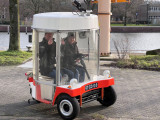
Toen ik als kleine jongen na lang zeuren eindelijk eens op de skelter van de buurjongen mocht rijden, was ik als kind zo blij. Hetzelfde overkwam me, zoveel jaren later nog eens vlak voor het einde van 2022. Door onze Community Manager Sophie was ik geattendeerd op een klein berichtje van NEMO de Studio, een soort dependance van NEMO met een eigen tentoonstelling ('energy junkies') op het Marineterrein. Praktisch buren van Amsterdam Smart City, waar ik sinds halverwege 2022 anderhalve dag per week werk op het thema mobiliteit.
NEMO de Studio ging rijden met de Witkar en je mocht mee, tenminste, als je de 'prijs' won. Daarvoor hoefde je alleen een mailtje te sturen. Nu ben ik dol op prijzen waar ik nagenoeg niets voor hoef te doen, dus dat mailtje was zo gestuurd. En tot mijn verbazing bleek ik gewonnen te hebben. Dus daar ging ik, op 29 december, naar NEMO de Studio.
Natuurlijk had ik Sophie en Pelle (mijn compagnon op het thema mobiliteit) meegevraagd en gedrieën werden we ontvangen door Jodie en Maaike van NEMO. De Witkar was aan het opladen, gewoon met een stekker in het stopcontact. Een driewieler die inderdaad grotendeels wit is, met een mooie rode bies aan de onderkant, en in de verte iets wegheeft van de Pausmobiel. Hoog en rondom ramen. Vanwege de mooie ronde koplampen doet het denken aan Brum, het oldtimer autootje met de ronde koplampen als ogen.
De Witkar reed tussen 1974 en 1986 rond in de stad. Het is feitelijk de eerste elektrische deelauto in Amsterdam. De bedenker ervan, Luud Schimmelpennink, is ook bekend van het Witte Fietsenplan. In totaal zijn er 38 Witkarren gemaakt waarvan er zo'n 25 daadwerkelijk hebben rondgereden. De autootjes stonden in speciaal gebouwde laadstations en konden door leden tegen een vergoeding gebruikt worden. Het was een non-profit initiatief; de opbrengsten werden beheerd door een stichting en werd geïnvesteerd in beheer en uitbreiding van het systeem. Hoeveel mensen er daadwerkelijk gebruik van hebben gemaakt is mij niet bekend.
En nu mocht ik het dus ook proberen. Zelf sturen zat er helaas niet in, maar meerijden is ook al een belevenis. De 'handrem' werd weggenomen, gewoon een stuk blok dat achter de wielen wordt gelegd (een echte handrem was kennelijk niet nodig). Na plaatsgenomen te hebben in de ovale coupé op het Gispen (jawel!) stoeltje naast Jodie die voor deze gelegenheid ook chauffeur was, kon het avontuur beginnen. Voor de gelegenheid hadden de dames een jaren 70 Spotify lijstje opgezet op een JBL- speakertje die achter de stoelen was gelegd (ruimte genoeg). Oude en nieuwe technologie die naadloos samengaan.
Nog even de gordel aan en hup het gaspedaal werd ingedrukt. Soepel accelereerde het karretje naar zo'n 15 km per uur. Het maximum ligt op 30 km/u maar het Marineterrein leent zich daar niet echt voor. Het ritje was niet heel comfortabel, door het gebrek aan schokdempers voel je elk hobbeltje. En door de vele kieren hebben wind en regen vrij spel. De Witkar zou in deze tijd ook ongetwijfeld worden afgekeurd voor gebruik op de openbare weg. Maar net als op de skelter destijds, heb ik ontzettend genoten. Wat een heerlijke ervaring! Comfort en gemak zijn hier niet het belangrijkste. Net zoals bij bijv. kamperen zijn andere zaken veel interessanter dan het comfort van een huisje of hotel. Plezier, authenticiteit, vrijheid, verbinding, avontuur, weg uit de hokjes, verzin het maar: de Witkar biedt het. Een mooie uitvinding van een visionaire man die zijn tijd duidelijk ver vooruit was. Dus, mag ik ajb nog een keer? Mijn buurjongetje destijds verhuisde vrij snel. Maar hopen dat deze buren lang op het Marineterrein blijven!
City deals: Shaping collaboration between cities

The 15th episode of the Better cities - The contribution of digital technology- series is about collaboration between Dutch cities within the City Deals in the Agenda stad en regio project.
Over the past years, the interest Dutch municipalities in digitization at urban level has increased, partly because of the initiating role of the VNG, G40, the Future City Foundation and forerunners such as Apeldoorn, Helmond, and Zwolle as well. Initially, these were small-scale and isolated projects. In this post, I'll discuss two projects that aim at scaling through collaboration.
A mission-driven approach to public sector projects
In her new book, Mission Economy, Mariana Mazzucato advocates a mission-driven approach to public sector projects at the local level in the way that a man was put on the moon. She refers at large-scale projects with a high degree of complexity, such as the energy transition, the construction of affordable housing, the well-being of the poor part of the population and the conservation of nature.
What is a mission-driven approach? At first, it includes an ambitious vision, followed by breaking down silos within the governmental organization, collaboration within the quadruple helix, and cooperation between higher and lower governments.
A mission-driven approach is appropriate for the major transitions facing the world and digitization as a part of these. The following pertains to a couple of projects that aim at such an approach. The first, Agenda city and region has been running for some time and will be dealt with extensively. The other is initiated by G40 will be discussed briefly.
Agenda stad and City deals
In Agenda city and region, cities, governments at different levels, companies, and organizations, including the VNG, G4, G40 and Platform31, work together to drive innovation in cities. The mission is summarized in SDG 11: Make cities inclusive, safe, resilient, and sustainable. The most important instrument are City Deals: collaborative ventures around a themes.
The first City Deals started in 2016, there are now 27, about half of which have been completed, but six new ones are about to start. 125 municipalities, 8 provinces, 9 ministries, 10 other government agencies, 5 water boards, more than 100 companies, 30 knowledge institutions and more than 20 other partnerships are involved. There are now 14 partnerships with municipalities outside the Netherlands.
Examples of City Deals are: Working and doing business across borders, cleantech, food on the urban agenda, local resilience against cybercrime, inner city building, the inclusive city, and smart city, that's how you do it. The latter will be discussed below.
Within a City Deal, the parties involved work together in their own way on concrete products, ranging from legislation to policy instruments. The main principles are:
- Formulating an ambition and a strategy.
- Enabling scaling through cooperation between and/or within (urban) regions.
- Realizing collaboration between public and private parties, including the central government
- Innovating by realizing new forms of problem-solving.
- Scaling up, also across national borders.
City Deals also work together and new deals are created from among them, such as ‘Smart customization', a new City Deal that arises from the existing City Deals 'Simple customization' and 'Smart city, that is how you do it'. If I had to imagine how a moonshot works, which I referred to in the introduction of this article, then Agenda city and region could be a good example.
City deal 'A smart city, this is how you do it'
The goal of this City Deal, as we read in the annual report, is to use digitization to tackle the major challenges facing Europe and the Netherlands, such as poverty, social cohesion, and insecurity, and to achieve a society in which everyone can live in freedom. 60 parties are now involved in this City Deal.
The aim is to change at least 12 processes by which regions, cities and towns are designed, organized, managed, and governed, and to make the most of the opportunities offered by digitization. The starting point is the existing practice and aimed at matching city’s demands.
The City Deal 'Smart city, this is how you do it', has 14 working groups. Each of those have chosen which a process to tackle, on the understanding that three municipalities must be prepared to test the results and can be scaled eventually. The City Deal 'A smart city, this is how you do it' has been underway for almost two years now, and the processes to be tackled have crystallized. In a few cases prototypes are ready, most are under development. Below is a brief description of the situation on November 15th, 2021. A lively description of some participants’ experience can be read in ROMmagazine, volume 39, no. 11.
1. Open urban data platform
This project is developing a procedure for tendering an open data platform, which is shareable and scalable, in which privacy and data autonomy are guaranteed and that offers sufficient precautions for cybersecurity. The result will be a step-by-step plan, in which technical questions (what it will looks like), legal questions (who is the owner) and financial questions (funding) are discussed.
2. Cookbook for effective data strategy
This project develops a procedure for the acquisition and storage of data. A 'data cookbook' has been developed that supports the collection, storage, and application of data. It offers an 11-step plan from the formulation of a measurable questions to the interpretation of the measurement results. It accentuates the importance to make explicit the assumptions behind the selection of data. The usability of the steps is tested in practice. A first concept can be found here.
3. Smart initiatives test
The aim of this project is to allow initiators (citizens, companies) to make optimal use of available public data, including those that will be provided by the DSO (digitaal stelsel omgevingswet). The DSO will provide information about which rules apply at a specific location and ultimately also about the quality of the physical living environment itself. Ideally, the ‘smart initiatives test’ will collect and optimize all data needed for a plan. The project group is currently investigating which types of (geo) data users need most ('usercases').
4. Sensor data and privacy
The aim of the project is to develop a tool that allows a municipality to tender for the installation of sensors that exactly match the type of data that will be collected and that consider ethical questions and GDPR rules.
5. Design of the new city
The growing availability of various types of (real-time) data, for example about air quality and noise pollution) has implications for the way in which cities and neighborhoods are developed. The working group is developing a canvas that functions as a ‘translator' of available data. The starting point for its development was a matrix with as inputs the phases of the design process (initiative, design and realization phase) and the area type (urban, Randstad and suburban area). This matrix must indicate which data is needed at what time. The usability will be tested through pilots.
6. Everyone (and everything) a sensor
Citizen measurement initiatives (via telephones and with sensors attached to bicycles, cars, and homes) have a double goal: to increase citizen’s involvement and to improve the insight into living environment of those who execute the measurement. It can also contribute to behavioral change, especially if the measurements match the needs of residents and they are also involved in the interpretation of the results. The working group is striving for a roadmap based on several user cases.
7. Local measurement: comparing projects
Measuring data locally – as was done in the previous project – may be redundant if data from elsewhere is available. In that case, comparability is required with data being searched for and standardization is needed to enable such a comparison. However, standardization can lead to mistrust and remove the incentive for resident groups to get started themselves. Ultimately, the working group opts for the development of a self-service portal, which will be developed together with the Healthy Urban Living Data and Knowledge Hub. Resident groups can then choose for themselves to participate in a standardized project that reads their measurement results directly or for a 'do-it-yourself' solution. A manual will be written for this last option.
Both projects are being further developed in collaboration with Eurocities, a network of 190 cities in 38 countries, under the name CitiMeasure - using citizen measurement to create smart, sustainable and inclusive cities.
8. Smart mobility: Towards a safe and sustainable city
Digitization in traffic has already taken off, for example by intelligent traffic systems (IVRIs), but usually the existing situation, for example private use of cars, is the starting point. The question is how to connect to the pursuit of a better quality of life. To this end, the working group has chosen three themes: better accessibility for emergency services, shared mobility, and city logistics.
A step-by-step plan is being developed for emergency services, with which municipalities can realize the necessary facilities to always priorize emergency vehicles – and possibly other target groups as well.
If everyone were to travel with the most suitable means of transport at that time (varying from walking, (shared) bicycle or scooter, public transport to (shared) car, private car use would decrease considerably and thus improve the quality of city live. Additionally, the working group is developing a 'map' to encourage shared mobility, which provides answers to all related questions.
Developments in city logistics are already taking place via other routes. Therefore, the contribution of the working group in this regard will be limited.
9. A business model for the smart city
New forms of collaboration between governments, the business community, knowledge institutions and citizens can result in new 'values' for areas, but also to the need to allocate costs and benefits in a different way. A new 'business model' may then be necessary. To this end, the working group is investigating the consequences for companies and organizations of entering partnerships for the successful development of products and services. This compared to more traditional client/contractor relationships.
10 Ethical Boards
Within the City Deal 'A smart city, this is how you do it', a rule is that digital instruments to be developed always comply with ethical principles. The implications of such principles are often situational. That is why municipalities are setting up an 'ethical board', which includes experts and residents. To support its work, the committee wants to create a knowledge platform that informs which ethical principles or tools suit best for different digitization projects.
11 Model Acquisition
Local authorities want to regulate the use of digital tools such as sensors in public spaces. Anita Nijboer, who works as a lawyer at Kennedy Van der Laan, who is also a partner of the City Deal 'Smart city, this is how you do it', has drawn up a model regulation for this purpose, which has already been tested in Rotterdam and Helmond. The most important learning effect is that departments within a municipality have fundamentally different view of the way in which these types of questions should be legally framed. In response to this, the working group is examining the question of whether a model regulation is an appropriate answer to obtaining consent for the use of digital tools.
12 Dealing with crowds in the city
Measuring (too large) crowds in parts of the city was a problem long before corona times. The aim is to develop a digital model ('digital twin') of the city - a so-called crowd safety manager - that provides real-time insight into pedestrian flows and concentrations. Such a model must also be able to communicate with people in the city. A prototype of a dashboard, developed by partner company Argaleo, is now being used in 's-Hertogenbosch, Breda and The Hague. This instrument does not use any personal data. It is being further developed at European level with external subsidies.
The instruments to be developed and existing instruments have been brought together via a website, the Toolbox. Other City Deals also develop knowledge, which is far from being systematically documented. That is why the best way to distribute this knowledge is investigated together with the Knowledge Lab for Urbanism.
G40: Smart sustainable urbanization
In March 2021, G40, the umbrella organization of 40 medium-sized municipalities, submitted a project proposal to promote digitalization and thus also create opportunities to the business community.
The project plan rejects the current approach of 'smart urbanization' and the realization of 'main social tasks'. Decentralization, broadening of tasks, narrowing of implementation funds and a fragmented central government policy have led to an impeding control gap and financing deficit in municipalities. Instead, a bundled approach is wanted, led by representatives of municipalities and central government, and the latter is being asked to invest € 1 billion.
When studying this plan, I was surprised by the absence of any reference to the activities of Agenda city and regioand the City Deals. Instead, one wonders whether Agenda city and region is the subject of criticism of the fragmented approach and G40 wants to get rid of it.
The strength of Agenda city and region is the cross connections between urban projects of all kinds, the involvement of citizens and intermunicipal cooperation. This is something to cherish.
In my opinion, G40 would be better off by ushering in a new phase of Agenda city and region, characterized by economies of scale and acceleration of the findings so far. The aims of this new phase could be consolidation of the cohesion between the themes of the individual City Deals within the framework of the major transitions facing the Netherlands. The theme of digitization thrives best in this context. After all, the ultimate value of digitization lies in the contribution to the energy transition, the reduction of traffic nuisance and the growth of a circular economy, to name a few examples. However, that requires a different plan.
In the meantime, I hope that in the foreseeable future we will be able to see the results of the working groups of the City Deal 'Smart city, this is how you do it', together with those of the other 'Deals'.
Follow the link below to find one of the previous episodes or see which episodes are next, and this one for the Dutch version.
Amsterdam launches bike safety innovation competition
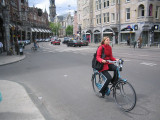
Amsterdam is inviting universities, companies and members of the public to come up with solutions to improve bike safety in the Dutch capital through an open challenge.
The central theme of the competition – “Different speeds on bicycle paths” – aims to influence the behaviour of road users and asks how bike delivery services, and differences in speed bicycle types can impact this.
Applications are open until February 24, with the winner set to be announced on April 11.
The first part of the serie 'Better cities - The role of technology' is online

Six weeks ago, I started a new weekly series answering the question how digitization can contribute to the development of better cities and their surroundings. Technology alone cannot reach this goal. Far-reaching social and economic reforms are needed, also to ensure that the benefits of digitization are shared by everyone.
Below you will find links to the articles published until now:
Part A: Digital technology as a challenge
1. Prologue to a new series: Better cities. The role of digital technologies
2. Scare-off the monster behind the curtain: Big Tech’s monopoly
3. Ten years of smart city technology marketing
4. Digital social innovation: For the social good (and a moonshot)
5. Collect meaningful data and stay away from dataism
6. The Boston Smart City Playbook
7. The Future of Urban Tech. A project of the NYC Cornell University
Next up:
Part B: Digital instruments and ethics
8. Digital technology and the urban sustainability agenda. A frame
9. Ethical principles for digital technology
10. Accessibility, software, digital infrastructure, and data. The quest for ethics
11. Ethical principles and artificial intelligence
12. Ethical principles and applications of digital technology
13. Amsterdam benchmarked
14. ‘Agenda stad’ and digital instruments
Part C: Applications
15. Artificial intelligence abused
16. Government: services and participation
17. Mobility
18. Circular economy: Construction
19. Circular economy: Waste
20. Resilience
21. Energy transition
22. Health
23. Smart cities from scratch
24. Epilogue
Links to the Dutch versions, you will find below:
Amsterdam Reist Slim: doe mee aan de proef!

De gemeente Amsterdam en de Hogeschool van Amsterdam starten in november 2021 een onderzoek naar het reisgedrag van Amsterdammers. Een bereikbare en leefbare stad begint bij de behoeften van de inwoners. Hoe vaak, wanneer en met welke voertuigen verplaatsten ze zich door de stad? Dat zijn vragen waar we met de proef antwoord op willen krijgen.
Over het onderzoek
De proef wordt uitgevoerd met behulp van de slimme app Fynch. Fynch biedt niet alleen een helder overzicht van iedere gemaakte rit, ook de CO2-uitstoot, afgelegde kilometers, vermeden spitsuren en aantal minuten beweging per dag worden bijgehouden. De Hogeschool van Amsterdam onderzoekt het reisgedrag van Amsterdammers via de ritten in de app en stuurt tijdens het onderzoek twee vragenlijsten om nog meer te weten te komen over de reisbehoeften van de deelnemers.
Doe mee aan de proef
Woont u in Amsterdam en heeft u een auto? Meld u dan aan via onderstaande link! U draagt bij aan de ontwikkeling van een leefbare en bereikbare stad en ontvangt na afloop van de proef een bol.com bon van €20.
Join the Code the Streets pilot to contribute to a safe and liveable Amsterdam

Code the Streets is a European urban mobility project that explores digital solutions to improve mobility and public space management of the future. Public and private partners from Amsterdam and Helsinki set out to answer the question: “How can cities share information with service providers on the desired use of public space and stimulate drivers to choose the most ‘social’ route?”
As metropolitan areas continue to grow, so do traffic related issues such as congestion, safety concerns, air pollution, and pressure on fragile infrastructure. In a world of digitalisation, climate change and increased awareness of the social and ecological environment, cities are faced with the challenge of finding better ways to manage urban mobility and their public spaces.
Code the Streets supports cities with this challenge by creating a basis for new digital mobility management tools and by showcasing the benefits of collaboration between the public and private sectors. Instead of just using road signs - a traditional way to direct traffic - this collaboration gives cities the opportunity to communicate with drivers through service providers. By adding data about school zones, congestion, and pollution to an existing navigation app, cities can stimulate car users to choose an alternative, and more ‘social’ route. One that is aligned with the city’s values such as safety, accessibility, liveability, and sustainability.
During the months of September and October, the Code the Streets team will run pilot programs testing the application in Amsterdam and Helsinki. Interested in trying the app? Android users can sign up here.
For more information about the pilot and the outcomes visit www.codethestreets.eu
Code the Streets is a collaboration between Aalto University, Amsterdam Institute for Advanced Metropolitan Solutions (AMS Institute), City of Amsterdam, City of Helsinki, Forum Virium Helsinki, Technical University Delft, TomTom, Mercedes-Benz and The Future Mobility Network, with support from EIT Urban Mobility.
Onderzoek: Deelmobiliteit in Almere! / Enquête
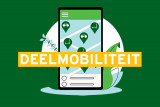
Almere is een stad waarin de mogelijkheden om jezelf te verplaatsen eindeloos zijn. Niet alle vervoersmiddelen zijn even praktisch, milieuvriendelijk of gezond. Veel van onze auto’s staan het grootste gedeelte van de tijd stil op de parkeerplaats. Ze nemen kostbare ruimte in en daarbij zorgt het gebruik van de auto voor een minder gezonde lucht.
Wat is deelmobiliteit?
Een oplossing hiervoor kan zijn om voertuigen te delen. Dit noemen we ook wel deelmobiliteit. Niet iedereen een eigen auto, maar één auto die wordt gebruikt door meerdere personen. Naast een auto kun je ook (e-)fietsen of scooters delen. Deze zijn belangrijk om bijvoorbeeld het laatste stukje van het treinstation of bushalte gemakkelijk naar je werk te komen.
De gemeente Almere is benieuwd hoe jij hierover denkt. Jouw mening kunnen we gebruiken bij het opzetten van deelmobiliteit in onze stad. We gaan betrouwbaar om met uw gegevens en de reacties worden anoniem verwerkt. Vul voor ons de enquête in!
Wat vind jij? Verdient serious gaming een stevigere plek in het aanpakken van transities?
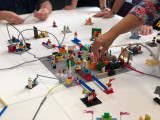
Serious gaming is een mooi hulpmiddel voor samenwerking en
besluitvorming in de energietransitie. In de afgelopen jaren hebben we
voorbeelden gezien van spellen die complexe vragen begrijpelijk kunnen maken. Neem bijvoorbeeld de HEAT tool van Alliander, het WE-Energy spel van de Hanzehogeschool Groningen, de sustainability DNA game van de Ceuvel, het Klimaatspel Plan Zuid van de Gemeente Amsterdam en het participatiespel van de Hogeschool van Amsterdam. Stuk voor stuk interessante serious games die ingewikkelde processen van verduurzamingsopgaven eenvoudiger maken.
De Hogeschool van Amsterdam en Amsterdam Smart City zoeken samen hoe we de meerwaarde van serious gaming voor energieprojecten kunnen verhogen. Enerzijds omdat we ons afvragen of de potentie wel volledig wordt benut. Anderzijds omdat opvalt dat structurele toepassing, of op grotere schaal, uitblijft. De zoektocht staat nog ver aan het begin, maar we gaan graag met anderen hierover in gesprek. En daarom vragen we jou om met ons mee te denken.
Voor wie zijn serious games?
Serious games zijn er genoeg, maar ze verschillen in de inhoudelijke focus, schaalniveau en doelgroep. Sommigen gaan uitsluitend over energie, anderen ook om andere aspecten van gebiedsontwikkeling. Daarbinnen kan het gaan over een hele regio of een bepaalde buurt. Omdat de energietransitie gaat om multistakeholder samenwerking, hebben meerdere doelgroepen baat bij het spelen van een serious game over dit onderwerp. Denk aan beleidsmakers en (nuts)bedrijven, die bijvoorbeeld moeten samenwerken om een warmtenet te realiseren.
Een doelgroep die hier niet kan ontbreken is natuurlijk de bewoner. Voor hen lijkt de toegevoegde waarde van serious games nog wel het grootst. Juist vanwege de laagdrempeligheid van een serious game is het bij uitstek een middel om mensen te helpen complexe informatie te begrijpen. Hoe meer je speelt, hoe beter je het begrijpt. En het begrijpen van een onderwerp is een belangrijke voorwaarde om mee te kunnen denken, praten en besluiten over een onderwerp. Een belangrijke reden om dit soort spellen extra serieus te nemen. Bovendien biedt een spel de mogelijkheid om gelijkwaardig met elkaar in gesprek te gaan. Verschillen in sociaaleconomische status zijn eigenlijk niet van belang. Sterker nog, spellen bieden juist gelegenheid om in elkaars schoenen te staan. Het helpt om elkaars perspectieven te begrijpen, of je nu bij de gemeente werkt, bij een netbeheerder, een woningcorporatie, of je huurder bent of woningeigenaar. Zo zijn er nog wel meer voordelen te benoemen. Voordelen die ook kunnen gelden voor andere transities dan de energietransitie.
Kansen
In de praktijk lijken we deze voordelen niet voldoende te benutten. Serious gaming voor de energietransitie is weliswaar op verschillende plekken ontwikkeld, maar in beperkte mate, en niet structureel toegepast. Daar komt bij dat we er ook weinig van weten. Welke spelmechanismes werken en welke niet? Wanneer zet je zo’n spel het beste in? Bij het ophalen van ideeën, de daadwerkelijke besluitvorming, of ook in de evaluatie? Zijn er eigenlijk ook risico’s? Zijn er redenen om serious gaming absoluut niet te willen gebruiken in het energieneutraal maken van wijken?
En dan nu de vraag aan jou!
Om de zoektocht kracht bij te zetten vraag ik namens Amsterdam Smart City onze community om hulp. Hoe kijk jij aan tegen serious gaming als middel om te werken aan transitieopgaven? Zie je de toegevoegde waarde van zo’n game voor buurtparticipatie? En van welke voorbeelden zouden we moeten leren – of wellicht als netwerk moeten door ontwikkelen?
We zijn benieuwd naar je ervaringen! Laat je reactie achter in de comments!
Check start met belonen correct parkeren deelscooter

Elektrische deelscooter aanbieder Check introduceert vandaag als eerste aanbieder in Nederland een omvangrijk beloningsprogramma om correct gebruik van haar deelscooters te stimuleren. Alle gebruikers van Check doen automatisch mee en sparen vanaf vandaag op verschillende manieren voor gratis ritten. Een van de manieren om beloond te worden is het netjes parkeren van een deelscooter. Op die manier stimuleert Check haar gebruikers om op een verantwoorde manier om te gaan met de publieke ruimte. Dit draagt bij aan de uiteindelijke missie van Check - het leefbaarder maken van steden.
Gebruikers verdienen Coins met netjes parkeren
Het beloningssprogramma heet Coins en heeft een simpele structuur. Alle gebruikers doen automatisch mee en kunnen op verschillende manieren Coins verdienen. Bij 10 Coins krijgen ze de volgende rit gratis. Een van de manieren om een Coin te verdienen is door een positieve parkeerbeoordeling te ontvangen. Iedere gebruiker beoordeelt hoe de scooter door de vorige gebruiker is achtergelaten. Bij een positieve beoordeling ontvangt de vorige gebruiker een Coin. Met deze aanmoediging loont het voor gebruikers om na te denken over hun parkeergedrag en de scooter netjes achter laten. Er wordt niet alleen beloond. Als een gebruiker in een bepaalde periode drie keer een negatieve beoordeling heeft ontvangen volgt een tijdelijke blokkade van het platform.
Check investeert in gebruikers en niet-gebruikers
Gebruikers kunnen elkaar dus een beloning toekennen. Toch is Check niet bang voor hoog oplopende kosten. Paul van Merrienboer, mede-oprichter van Check, is juist blij als het programma op grote schaal wordt gebruikt: “Ons doel is om de makkelijkste weg door de stad aan te bieden. Niet alleen voor gebruikers van onze dienst maar voor álle inwoners van de stad. We bieden pas een echt duurzame oplossing als we met onze gebruikers extra oog hebben voor de schaarse publieke ruimte. We willen probleemloos integreren in steden en zien deze beloning als een investering in de toekomst.”
Een aanmoediging voor duurzame mobiliteit
Ook op andere manieren kunnen gebruikers Coins verdienen, bijvoorbeeld door het maken van een rit langer dan 10 minuten. Onderzoek door de gemeente Rotterdam wijst uit dat 23% van de deelscooterritten in 2020 een autorit verving. Om deze overgang verder aan te moedigen heeft Check eerder al een starttarief ingevoerd op iedere rit. Hierdoor zijn zeer korte ritten relatief duur. Vanaf vandaag worden langere ritten dus ook beloond met extra Coins. Hierdoor wil Check haar gebruikers stimuleren om nog vaker de auto te laten staan. Ook wil Check middels Coins de omloopsnelheid van deelscooters die lang stil staan vergroten. Door een lang stilstaande scooter te gebruiken ontvangen gebruikers Coins. Op deze manier wordt overlast voorkomen.
Zelf ontwikkelde technologie als oplossing
Check heeft het programma in korte tijd weten te ontwikkelen en implementeren. Marco Knitel, mede-oprichter van Check, licht toe: ‘We zien de urgentie van het probleem en omdat we ons platform zelf hebben gebouwd, waren we in staat het programma snel te ontwikkelen.’ In het ontwerpen van de oplossing zijn keuzes gemaakt waar Check trouw blijft aan haar belofte: de makkelijkste weg door de stad aanbieden. Knitel: ‘We willen zo min mogelijk verplichte schermen hebben tijdens het boeken van een rit. Dat proces moet intuïtief, snel en makkelijk zijn.’ Om deze reden is het niet verplicht om een geparkeerde scooter te beoordelen. Het gaat erom dat gebruikers leren herkennen wanneer er sprake is van een goed- of fout geparkeerde scooter en elkaar er in die gevallen op aanspreken.
The impact of COVID-19-lockdown on EV charging
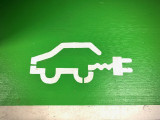
With the lockdown, traffic in the Netherlands largely came to a halt. Electric vehicles were no exception. What are the consequences for the use of public charging infrastructure? And how has the charging behaviour of electric drivers changed? Rick Wolbertus, researcher of the Future Charging project at the Hogeschool van Amsterdam (AUAS), about an initial analysis of the changed use of public charging points. 'Working from home not only makes a difference in traffic jams, it especially had a positive impact on peak loads on the electricity grid.'
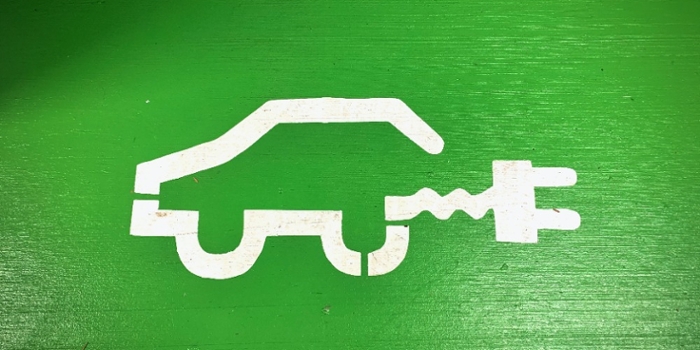
Image: Ralph Hutter / Unsplash
After the lockdown on March 12 2020, there was a lot less driving. Of course, this also applies to electric vehicles. In the Netherlands, about 50% less car driving and that is also reflected in the number of kWh that is charged at public charging stations. It is striking that the use of fast chargers fell faster than the use of level 2 stations. Level 2 stations were used about half as much while the use of fast charging stations (in the city) became about 80% less. The reference date for these numbers is the 3rd of February (February 1st is a Saturday).
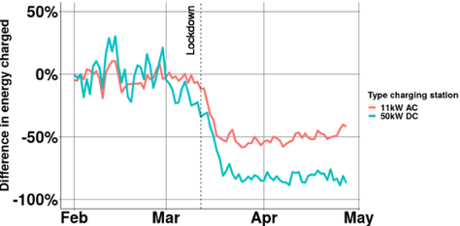
In the second figure, we compare shared cars with regular users. It is striking that shared cars keep pace with private use in the number of kWh charged. Although these cars are used by several people, there seems to be no additional fear of getting infected in shared cars.
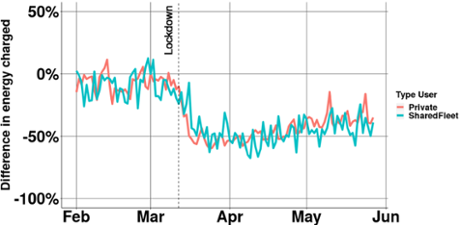
The third figure also shows that slowly traffic levels are returning back to normal. In particular, the number of different users is slowly returning to the pre-corona level. At the end of May, there were only 20% fewer users than before the lockdown. For the total energy that is charged, so the number of kilometers driven, we see that this is falling slightly behind. Compared to mid-March, there is already 10% more loading at the end of April.
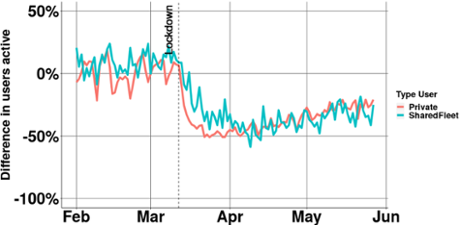
In terms of charging behavior, we also see a change, especially in the average time that a car is connected. For regular users, this average was around 10 hours, but in corona time it jumped to 15 hours, with some outliers on weekends. This was to be expected and is still relatively low compared to the decreased number of kilometers driven. In addition, the downward trend has started again. It is also positive that the connection time for shared cars is almost back to normal. It is clearly visible
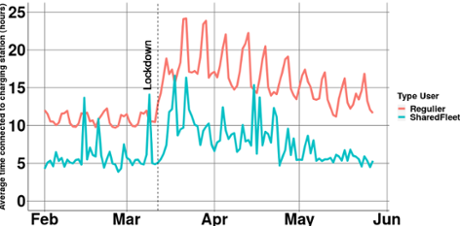
It is also striking that the that time when EV drivers charge has changed since the lockdown. Especially the peak in the evenings has become a lot less. At the same time, more is charged especially during the day. So EV drivers go for (electric) rides to the super or hardware store, but commuter traffic has decreased a lot. In addition, all traffic is spread out during rush hours. Even after the lockdown eased after May 11, this trend is still visible. The trend towards more working from home therefore also has a significant (positive) impact on energy demand, especially during peak hours. Working from home therefore saves both traffic jams and peak loads on the electricity grid.
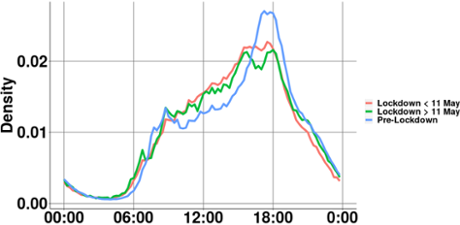
In conclusion, we see that electric transport is hit as hard by the corona crisis as transport in general. It is striking that fast chargers are used less than regular charging stations. Fast charging often shows in previous research in addition to regular charging, to cover longer distances in one day. The sharp fall in the need for fast charging can indicate a significantly reduced daily driving distance for many drivers such as taxis. Cars will stay connected to the charging station longer than before, but less than might be expected. The trend towards charging behavior before the corona crisis seems to have started again.
More information?
Project page Future Charging
Centre of Expertise Urban Technology
Research on Energy Transition
Social: Twitter, LinkedIn en Facebook
Stay up to date
Get notified about new updates, opportunities or events that match your interests.

